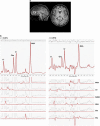An Examination of Rostral Anterior Cingulate Cortex Function and Neurochemistry in Obsessive-Compulsive Disorder
- PMID: 25662837
- PMCID: PMC4839510
- DOI: 10.1038/npp.2015.36
An Examination of Rostral Anterior Cingulate Cortex Function and Neurochemistry in Obsessive-Compulsive Disorder
Abstract
The anterior cingulate cortex is implicated in the neurobiology of obsessive-compulsive disorder (OCD). However, few studies have examined functional and neurochemical abnormalities specifically in the rostral subdivision of the ACC (rACC) in OCD patients. We used functional magnetic resonance imaging (fMRI) during an emotional counting Stroop task and single-voxel J-resolved proton magnetic resonance spectroscopy ((1)H-MRS) in the rACC to examine the function and neurochemistry of the rACC in individuals with OCD and comparison individuals without OCD. Between-group differences in rACC activation and glutamine/glutamate ratio (Gln/Glu), Glu, and Gln levels, as well as associations between rACC activation, Gln/Glu, Glu, Gln, behavioral, and clinical measures were examined using linear regression. In a sample of 30 participants with OCD and 29 age- and sex-matched participants without OCD, participants with OCD displayed significantly reduced rACC deactivation compared with those without OCD in response to OCD-specific words versus neutral words on the emotional counting Stroop task. However, Gln/Glu, Glu, and Gln in the rACC did not differ between groups nor was there an association between reduced rACC deactivation and Gln/Glu, Glu, or Gln in the OCD group. Taken together, these findings strengthen the evidence for rACC dysfunction in OCD, but weigh against an underlying association with abnormal rACC glutamatergic neurotransmission.
Figures


References
-
- Adler CM, McDonough-Ryan P, Sax KW, Holland SK, Arndt S, Strakowski SM (2000). fMRI of neuronal activation with symptom provocation in unmedicated patients with obsessive compulsive disorder. J Psychiatr Res 34: 317–324. - PubMed
-
- Alexander GE, DeLong MR, Strick PL (1986). Parallel organization of functionally segregated circuits linking basal ganglia and cortex. Annu Rev Neurosci 9: 357–381. - PubMed
-
- Bartha R, Stein MB, Williamson PC, Drost DJ, Neufeld RW, Carr TJ et al (1998). A short echo 1H spectroscopy and volumetric MRI study of the corpus striatum in patients with obsessive-compulsive disorder and comparison subjects. Am J Psychiatry 155: 1584–1591. - PubMed
-
- Baxter LR Jr., Phelps ME, Mazziotta JC, Guze BH, Schwartz JM, Selin CE (1987). Local cerebral glucose metabolic rates in obsessive-compulsive disorder. A comparison with rates in unipolar depression and in normal controls. Arch Gen Psychiatry 44: 211–218. - PubMed
Publication types
MeSH terms
Substances
Grants and funding
LinkOut - more resources
Full Text Sources
Other Literature Sources
Medical

